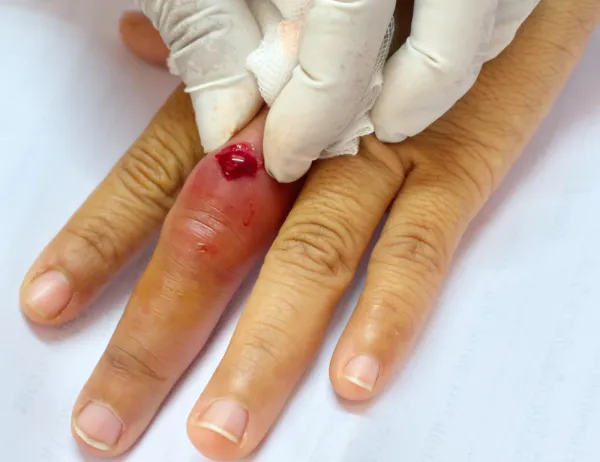Pediatric Coding Alert
Make Incision Decision Before Choosing FBR Code
These encounters could be FBRs, E/Ms … or both.
Coding for foreign body removals (FBRs) sounds so simple: the pediatrician removes the FB, and you choose the correct code for the procedure.
Not so fast: When your pediatrician performs FBR, encounter specifics will have to stand up to certain CPT® stipulations before you can decide on a code. Also, you’ll have to check the claim for a separate evaluation and management (E/M) service if you want to maximize your rightful reimbursement.
To get more familiar with coding FBRs, check out this input from those in the know.
Check for Incision First
For coding purposes, a soft-tissue FBR must meet CPT® guidelines, which are pretty straightforward.
The lowdown: If the pediatrician doesn’t make an incision during the procedure, then you cannot report 10120 (Incision and removal of foreign body, subcutaneous tissues; simple) or 10121 (… complicated).
“If the physician can just take forceps and grasp the foreign body and pull it, out then there is no separate coding for the service,” reports Marcella Bucknam, CPC, CPC-I, CCS-P, CPC-H, CCS, CPC-P, COBGC, CCC, internal audit manager with PeaceHealth in Vancouver, Wash.
Remember, 10120 and 10121 are for FBRs “in the subcutaneous tissue, just below the dermis. The foreign body could be anything, including a thorn, a splinter, or something left medically like an embedded staple or stitch that is not part of a regular postoperative removal of sutures or staples,” Bucknam explains.
Example: An 11-year-old established patient reports to the pediatrician complaining of pain in her left foot. The pediatrician examines the foot and discovers a small wood splinter. After several attempts to grab the end of the FB with tweezers, the pediatrician makes a small incision on either side of the splinter and then removes it. On the claim, you would report 10120 for the procedure.
When you don’t see any incision evidence, be sure to roll the work into the overall E/M level for the visit, confirms Suzan Hauptman, MPM, CPC, CEMC, CEDC, of ACE Med Group in Pittsburgh, Pa.
Example: An 11-year-old established patient reports to the pediatrician complaining of pain on the sole of her left foot. The pediatrician examines the foot, discovers a small wood splinter, and removes the FB by grabbing its end with tweezers. Notes indicate a level-three E/M service. On this claim, you’d opt for 99213 (Office or other outpatient visit for the evaluation and management of an established patient, which requires at least 2 of these 3 key components: an expanded problem focused history; an expanded problem focused examination; medical decision making of low complexity). Be certain that the note justifies the level of care chosen. Also, remember that the physician has to document the procedure by stating she explained the procedure to the parents/patient, how she performed it, what was the outcome, and how did the patient tolerate the procedure.
FB Location, Depth Could Complicate FBR
There are many factors that could play into the FBR being more difficult, Hauptman explains.
“Depending on what the foreign body is, where it is or how big it is will determine complexity. If the item is lodged deep into the skin or muscle — a bullet, a piece of glass, etc.—using other means to visualize it might warrant a more complicated process,” she says.
Also: How the item is embedded could also make the FBR complicated. The FB “might be close to a major organ or artery. It could be wedged under a bone,” Hauptman continues.
If you think you have a 10121 claim on your hands, be sure to check with the performing provider before coding. Many pediatric offices don’t treat these types of injuries, so a claim you consider 10121 might actually be a 10120 service.
Look for Separate E/M Evidence
OK, so you’ve decided that the clinician provided 10120 service. Don’t send that claim until you’ve checked the notes for evidence of a separate E/M service.
Hauptman says you can “absolutely” code for an additional E/M if you’ve got the notes to back it up. “You would need to clearly illustrate that the visit was separately identifiable,” she says. A separate E/M might occur, for instance, if the pediatrician first needed to find the cause of the patient’s pain. After determining that the pain is emanating from a subdermal FB, he performs an incision to remove the FB.
Also: Another E/M opportunity might occur if the pediatrician addresses a problem unrelated to the FBR, such as other injuries the patient suffered. “If you are only assessing the injury with the foreign body you are unlikely to be able to [code] a separate E/M,” Bucknam confirms.
Example: An 8-year-old new patient presents complaining of pain in his palm. His mother reports he was helping wash dishes, and his hand began to ache about an hour later. The palm is now red and swollen at the base. The physician performs an expanded problem focused history and examination, during which he finds a shard of glass in the patient’s palm. Notes indicate this service included straightforward medical decision making (MDM). After cleaning the wound and performing an incision, the physician removes the glass, bandages the patient’s wound, and instructs the mother and the patient on follow-up care.
In this scenario, you should report 10120 for the FBR. Then, report 99202 (Office or other outpatient visit for the evaluation and management of a new patient, which requires these 3 key components: an expanded problem focused history; an expanded problem focused examination; straightforward medical decision making) for the E/M with modifier 25 (Significant, separately identifiable evaluation and management service by the same physician or other qualified health care professional on the same day of the procedure or other service) appended to show the E/M was a significant, separately identifiable service.
Related Articles
Pediatric Coding Alert
- Procedure Coding:
Make Incision Decision Before Choosing FBR Code
These encounters could be FBRs, E/Ms … or both. Coding for foreign body removals (FBRs) [...] - Ask An Expert:
Use This Nosebleed Repair Coding FAQ, Stop Hemorrhaging Money
Know what epistaxis is? Read on to find out. In news that should shock absolutely [...] - Vaccinations:
Take These Tips to Heart to Cure Vaccination Coding Ills
Change coding when intranasal, oral admin occur. When your pediatrician orders vaccinations for a patient, [...] - You Be the Coder:
Diagnosing Type I Diabetes
Question: I have recently started working for a pediatric practice, and I’ve got a claim in [...] - Reader Question:
Make the Right Modifier Choice on CLIA-Waived Tests
Question: Our practice recently got its Clinical Laboratory Improvement Amendments (CLIA) waiver, and I just received [...] - Reader Question:
Take These Tips, Master Rhinitis Coding
Question: Could you describe the differences between the following rhinitis types: vasomotor, allergic and chronic? Also, [...] - Reader Question:
Getting Zika Diagnoses Right
Question: Have there been any changes in how you should report an ICD-10 code for the [...] - Reader Question:
Note Insurer to Keep HPI Counts on Point
Question: An established patient reports to the pediatrician with a chief complaint of abdominal pain. Notes [...]




